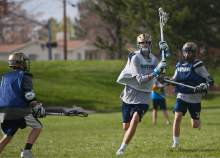This is an archived article that was published on sltrib.com in 2015, and information in the article may be outdated. It is provided only for personal research purposes and may not be reprinted.
As I watched a boys' soccer game at Granger High last Tuesday, I marveled at the number of sports available to high school students these days.
A couple of girls practiced softball. There was a tennis meet and a baseball game. Track and field participants practiced next to the football field where the soccer teams were battling. A member of the school's dance team sold candy in the stands as a fundraiser.
According to the Utah High School Activities Association, just under 90,000 students participate in the 10 girls' and 10 boys' sports it officially sanctions along with theater, music and debate.
That's impressive in its own right.
But there are numerous nonsanctioned sports with their own clubs and organizations that involve thousands of other high school students.
For example, about 2,000 boys and 1,000 girls participate in high school lacrosse. The Utah High School Cycling League fielded 67 teams serving 877 athletes last fall, in addition to even more junior high athletes. There are 24 high school varsity boys' hockey teams. The Utah High School Rodeo Association boasts 29 teams from mostly rural schools. At least 20 teams play in Utah Youth Rugby prep programs.
Add to that hundreds of high school cheerleaders who compete in state and national competitions, bowlers, target shooters, archers, gymnasts, weightlifters, figure skaters and skiers, and the opportunities seem almost endless.
The UHSAA board of trustees opened up the possibility of expanding its sanctioned sports opportunities last October by agreeing to have regions gauge interest and potential problems with adding lacrosse as a spring sanctioned sport for both girls and boys. This was a major change in that it lifted a moratorium on adding new sports.
The advantages of UHSAA sanctioning include securing playing fields, potentially expanding the number of participants and being part of an organization that provides coaching, insurance, officials, publicity, eligibility rules and equipment.
Administrators, though, have sometimes been reluctant to add new sports to an already crowded field, largely due to the expense.
In the case of lacrosse, for example, the sport requires helmets, pads and sticks, as well as not always easy to find playing fields. Hockey not only requires expensive equipment but paying for often hard-to-reserve ice time.
Lori Harward, executive director of the Utah Cycling League, said the benefit of a sport being sanctioned would be that more high schools and athletes might participate.
That said, like other non-sanctioned sports, high school mountain biking in Utah seems to be doing fine without state support.
"Organized the way we are, it gives student-athletes an avenue to a nontraditional sport," Harward said. "They can get involved in other ways, besides through the UHSAA. Our sport is in demand and growing like wildfire. In three years, we've grown to about 1,500 student-athletes. … There is an obvious need for non-traditional sports."
In mountain biking, all teams are co-ed. The top four times in a race are recorded, though both genders must count at least one time.
The sport isn't inexpensive. There is a $10 national membership, a $40 league sign-up and a $45 cost to enter each race. But the sponsoring group has donor bikes for those who can't afford to buy their own, discounts for multiple children from the same family, and discounts for athletes who sign up for every race.
"Our goal is not about winning," said Harward. "Our vision is to strengthen body, minds and character through life-long sport and make this so much fun that the students will ride the rest of their lives."
It will be interesting to see what the UHSAA board does about sanctioning lacrosse in the next few years.
With or without sanctioning, though, sports not directly sponsored by high schools will continue to thrive, as parents and young athletes seek out a specialized niche that offers both fun and success.
Sitting in the stands at Granger High on a beautiful spring afternoon and thinking about all the opportunities, my only thought was that this is a great time to be a high school student with so many sports and activities available.
Twitter: @tribtomwharton





